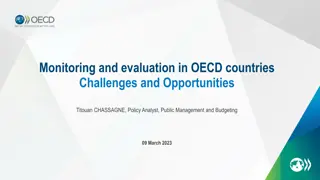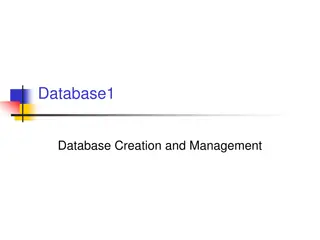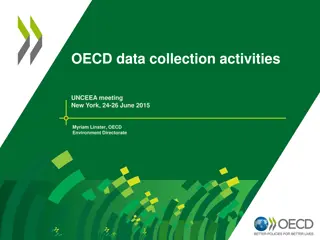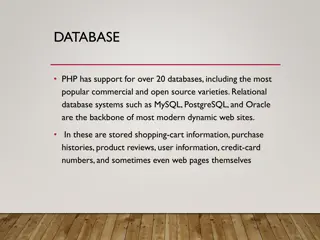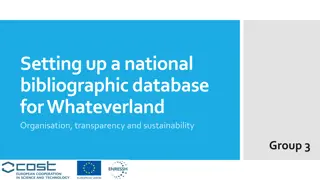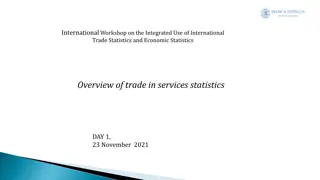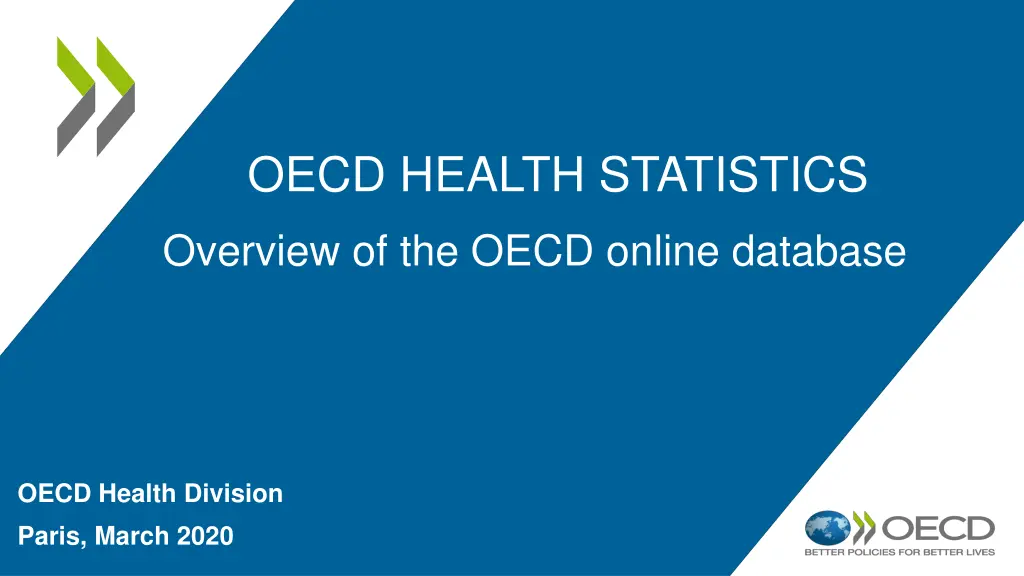
Explore OECD Health Statistics Database
Uncover a wealth of data on health status, care resources, quality indicators, and more in the OECD Health Statistics Database. Access key indicators, visualize data, and conduct comparative analyses across OECD countries to draw valuable insights. Discover datasets on life expectancy, healthcare utilization, pharmaceutical markets, and social protection. Learn how to access and utilize this comprehensive resource for informed decision-making and policy development in the healthcare sector.
Download Presentation

Please find below an Image/Link to download the presentation.
The content on the website is provided AS IS for your information and personal use only. It may not be sold, licensed, or shared on other websites without obtaining consent from the author. If you encounter any issues during the download, it is possible that the publisher has removed the file from their server.
You are allowed to download the files provided on this website for personal or commercial use, subject to the condition that they are used lawfully. All files are the property of their respective owners.
The content on the website is provided AS IS for your information and personal use only. It may not be sold, licensed, or shared on other websites without obtaining consent from the author.
E N D
Presentation Transcript
OECD HEALTH STATISTICS Overview of the OECD online database OECD Health Division Paris, March 2020
We are going to talk about 1 Data on offer 2 How to access those data Why are those data interesting and what could be done with them 3 4 5 Which other data sources could be linked More information about the data model 2
Content of the OECD Health database Datasets focusing on Health Status, i.e. life expectancy, infant mortality, perceived health status Non-Medical Determinants of Health / Risk factors, i.e. tobacco and alcohol consumption, overweight & obesity rates Health Care Resources, i.e. employment in health (physicians, nurse, etc.), graduates, remuneration, hospital beds Health Care Utilisation, i.e. consultations, screening, ALOS, waiting times Health Care Quality Indicators, i.e. hospital admissions, prescribing, patients safety, cancer care Pharmaceutical Market, i.e. consumption, sales, generics Long-Term care Resources and Utilisation, i.e. formal LTC workers, LTC recipients Health Expenditure and Financing Social Protection, i.e. public and private coverage Demographic References, i.e. population, by age and sex; and Economic References, i.e. GPD, average annual wages Access the full list of indicators available in the online database 3
Data dissemination: how to access the data All datasets are available in via https://oe.cd/ds/health-statistics Key indicators are further developed and analysed in Health at a Glance 2019: OECD Indicators (Read online or downloadable PDF options) Selected indicators are also available in the OECD Data Portal, which enables users to visualize the data 4
Background OECD Health questionnaires OECD Health Statistics based on 4 distinct questionnaires, administered by different teams across the OECD Health Division 2 of the data collections are managed in conjunction with other international organisations (Eurostat and WHO-Europe) The OECD Health Database offers the most comprehensive source of comparable statistics on health and health systems across OECD countries. It is an essential tool to carry out comparative analyses and draw lessons from international comparisons of diverse health systems Created in the 1990s, the database has never ceased to evolve to include relevant and high quality indicators Data are collected from all OECD members (36 countries) As well as key partners and accession countries via a Minimum Dataset Questionnaire
Other data sources to link to The database already relies on collaboration with other providers of data OECD data International providers Health and social employment Fertility All reference series (population, by age and sex; GDP, etc.) ECDC (AIDS, incidence of Measles, Pertussis & Hepatitis B) Eurostat (life expectancy, maternal and infant mortality, for EU countries) WHO (Causes of mortality, Alcohol consumption) National sources include health surveys, hospital registries, surveillance reports, taxation statistics, labour studies, etc. We encourage you to be creative, explore the data, build bridges !
Further information: visit http://www.oecd.org/health/health-data.htm Everything you need in one webpage Directa ccess to OECD.Stat datasets Frequently Requested Data for key indicators Direct access to all metadata, i.e. Sources and Methods by indicator and by country 8
Contact us health.contact@oecd.org Email us @OECD_social Follow us on Twitter www.oecd.org/health Visit our website 9

